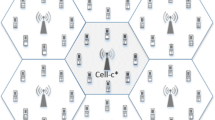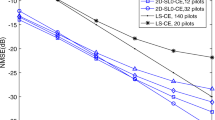Abstract
Massive MIMO is established by future wireless communication systems to facilitate real-time user applications with having a higher of data transfer rates and spectral efficacy through perfect channel knowledge. Many pilot reuse schemes are working to improve channel performance regarding pilot overhead and channel knowledge. However, the pilot contamination becomes a major challenging issue in massive MIMO applications due to erroneous channel state information between neighboring cells. To tackle this issue, analyzing to the estimation of channel parameters in the preferred paths and interference from neighboring cells in the underdetermined system is essential. For estimating the channel behavior over Sparse Bayesian and Compressed sensing Aided methods are proposed by surviving the Pilot contamination effects by changing the angular to beam domain for sparse channel approximation. Simulation results have demonstrated the effectiveness of Bayesian and compressed sensing by compared with the standard estimators in connection with estimation accuracy, especially in pilot contamination.




Similar content being viewed by others
References
Larsson, E. G., & Tufvesson, F. (2014). Massive MIMO for next generation wireless systems. IEEE Communications Magazine, 52(2), 186–195.
Muller, R., Vehkapera, M., & Cottatellucci, L. (2013). Blind pilot decontamination. In Proceedings, ITG workshop on smart antennas, Stuttgart (pp. 1–6).
Berger, C. R., Wang, Z., Huang, J., & Zhou, S. (November 2010). Application of compressive sensing to sparse channel estimation. IEEE Communications Magazine, 48(11), 164–174.
Nguyen, S., & Ghrayeb, A. (2013). Compressive sensing-based channel estimation for massive multiuser MIMO systems. In Proceedings IEEE wireless communications and networking conference (WCNC 2013), Shanghai, China (pp. 2890–2895).
Marzetta, T. L. (2010). Non-cooperative cellular wireless with unlimited numbers of base station antennas. IEEE Transactions, Wireless Communications, 9(11), 3590–3600.
Bajwa, W. U., Haupt, J., Sayeed, A. M., & Nowak, R. (2010). Compressed channel sensing: A new approach to estimating sparse multipath channels. Proceedings IEEE, 98(6), 1058–1076.
Han, Y., Lee, J., & Love, D. J. (2017). Compressed sensing-aided downlink channel training for FDD massive MIMO systems. IEEE Transactions on Communications, 75(7), 2852–2862.
Carlin, M., Rocca, P., Oliveri, G., Viani, F., & Massa, A. (2013). Directions-of-arrival estimation through Bayesian compressive sensing strategies. IEEE Transactions, Antennas Propagation, 61(7), 3828–3838.
Bayati, M., & Montanari, A. (February 2011). The dynamics of message passing on dense graphs, with applications to compressed sensing. IEEE Transactions on Information Theory, 57(2), 764–785.
Vila, J. P., & Schniter, P. (2013). Expectation-maximization Gaussian-mixture approximate message passing. IEEE Transactions on Signal Processing, 61, 4658–4672.
Wen, C. K., Jin, S., Wong, K. K., Chen, J. C., & Ting, P. (2014). Channel estimation for massive MIMO using Gaussian mixture Bayesian learning. IEEE Transactions on Wireless Communication, 14(3), 1356–1368.
Rao, X., & Lau, V. K. N. (2015). Compressive sensing with prior support quality information and application to massive MIMO channel estimation with temporal correlation. IEEE Transactions on Signal Processing, 63(18), 4914–4924.
Bjornson, E., et al. (2018). Massive MIMO networks: Spectral, energy, and hardware efficiency. Foundationsand Trends in Signal Processing, 11(3–4), 154–655.
Noh, S., & Zoltowski, M. D. (2014). Pilot beam pattern design for channel estimation in massive MIMO systems. IEEE Journal of Selected Topics Signal Processing, 8(5), 787–801.
Hoydis, J., Hoek, C., et al. (2012). Channel measurements for large antenna arrays. In Proceedings, IEEE international symposium on wireless communication systems (ISWCS’12), Paris, France (pp. 811–815).
Pati, Y. C., Rezaiifar, R., & Krishna Prasad, P. S. (1993). Orthogonal matching pursuit: Recursive function approximation with applications to wavelet decomposition. In Proceedings, 27th annual Asilomar conference, signals, systems, and computers (pp. 40–44).
Bandeira, A. S., Dobriban, E., Mixon, D. G., & Sawin, W. F. (2013). Certifying the restricted isometry property is hard. IEEE Transactions Information Theory, 59(6), 3448–3450.
Ledoit, O., & Wolf, M. (2004). A well-conditioned estimator for large dimensional covariance matrices. Journal of Multivariate Analysis, 88, 365–411.
Ziniel, J., & Schniter, P. (2013). Dynamic compressive sensing of time-varying signals via approximate message passing. IEEE Signal Processing, 61(21), 5270–5284.
Ji, S., Xue, Y., & Carin, L. (2008). Bayesian compressive sensing. IEEE Transactions, Signal Processing, 56(6), 2346–2356.
Donoho, D. L., Maleki, A., & Montanari, A. (2009). Message passing algorithms for compressed sensing. Proceedings of the National Academy of Sciences, 106(45), 18914–18919.
Su, P., & Wang, Y. (2019). Channel estimation in massive MIMO systems using a modified Bayes-GMM method. Wireless Personal Communications, 107, 1521–1536. https://doi.org/10.1007/s11277-019-06339-5
Author information
Authors and Affiliations
Corresponding author
Additional information
Publisher's Note
Springer Nature remains neutral with regard to jurisdictional claims in published maps and institutional affiliations.
Rights and permissions
About this article
Cite this article
Ravi Babu, T., Dharma Raj, C., Adinarayana, V. et al. Estimation of Sparse Channel Using Bayesian Gaussian Mixture and CS-Aided Techniques for Pilot Contaminated Massive MIMO System. Wireless Pers Commun 117, 1387–1398 (2021). https://doi.org/10.1007/s11277-020-07927-6
Accepted:
Published:
Issue Date:
DOI: https://doi.org/10.1007/s11277-020-07927-6




